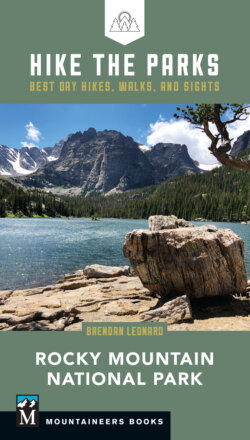Читать книгу Hike the Parks: Rocky Mountain National Park - Brendan Leonard - Страница 11
На сайте Литреса книга снята с продажи.
VISITING ROCKY MOUNTAIN NATIONAL PARK
ОглавлениеDating back almost to its establishment as a national park in 1915, Rocky Mountain National Park has made the alpine accessible to everyone, whether we want to climb a mountain under our own power or not. The park’s crown of Continental Divide peaks, rising 6000-plus feet (1829 m) above the gateway town of Estes Park (elevation 7522 feet/2293 m) on its east edge, can be seen up close with just a short drive from town. Trail Ridge Road, completed in 1932, makes it possible for anyone with access to a car to take in a view of the mountains from higher than 12,000 feet (3658 m), see the flora and fauna of the alpine tundra environment, and watch a thunderstorm roll in over the tops of the Rocky Mountains to the west.
For the 82 percent of park visitors who arrive from the east, the mountains of the park mark the beginning of the Rocky Mountains; it’s the far eastern edge of the high terrain that runs across the Lower 48 from Mexico to Canada, where the plains rise up thousands of feet into majestic peaks. The park is home to megafauna, like elk, moose, and black bears, as well as animals unique to alpine environments, including yellow-bellied marmot and bighorn sheep. Park visitors have a chance to take in the high-altitude scenery and wildlife without stepping more than a half mile from a car, and can also walk for days into the mountain wilderness, miles from the nearest road. Elk on the east side of the park, accustomed to humans and cars, can be seen grazing on the fairways of the Estes Park Golf Course, while elk high on the west side of the park seem wary of the rare human hiking through alpine tundra.
This book celebrates the accessibility of the park’s mountains by curating a variety of hikes, from stroller-friendly walks around lakes to high-altitude peak-bagging adventures, all within a short drive of a post-hike pizza, beer, or ice cream cone back in civilization afterward—or a seat in a camp chair in front of a fire in one of the park’s campgrounds.
